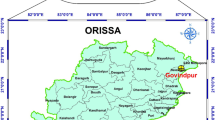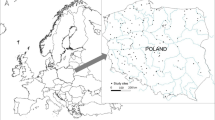Abstract
In the present research, external validation criteria and uncertainty analysis are conducted to predict maximum scour depth at downstream of the stilling basins using evolutionary polynomial regression (EPR) and model tree (MT) and nonlinear regression (NLR). Data sets used to develop models were collected from experimental models of stilling basins. Effective parameters on the scour depth were included those of discharge, approaching flow depth, mean flow velocity, geometric characteristics of stilling basins and physical properties of bed sediments at downstream of stilling basins. At first, MT and EPR models are implemented based on input–output data sets and result of performances for training and testing stages are evaluated. In addition, external validations and uncertainty analyses on the formulations given by EPR and MT are carried out using statistical errors functions and have absolute mean prediction errors less than that NLR technique. Finally, results of uncertainty and the prediction errors are compared with the GEP, MT, EPR and NLR models to select GEP model as a reliable model with the highest accuracy and smaller errors than other models.





Similar content being viewed by others
Abbreviations
- \(q\) :
-
Unit discharge of spillway
- \(g\) :
-
Acceleration due to gravity
- \(d_{50}\) :
-
Median sediment size
- \(\sigma_{\text{g}}\) :
-
Geometric standard deviation of sediment size distribution
- \(d_{\text{w}}\) :
-
Tail water depth
- \(h_{d}\) :
-
Spillway height
- \(L\) :
-
Length of stilling basin
- \(\rho_{\text{s}}\) :
-
Density of sediment
- \(\rho_{\text{w}}\) :
-
Density of water
- \(d_{\text{s}}\) :
-
Maximum scour depth
- \(l_{\text{h}}\) :
-
Length of the scour hole
- \(l_{\text{s}}\) :
-
Length of the deepest point of the scour hole
- m :
-
Maximum number of additive terms
- X i :
-
Model input variables
- Ŷ :
-
Model output variables
- ES(j,i):
-
Exponents of variables
- \(O\) :
-
Measured outputs
- \(\overline{O}\) :
-
Mean of measured output
- \(P\) :
-
Predicted outputs
- \(\overline{P}\) :
-
Average of predicted outputs
- \(M\) :
-
Number of data sets
- \(j\) :
-
Counter for sample of data sets
- R:
-
Correlation coefficient
- RMSE:
-
Root mean squared error
- MAPE:
-
Mean absolute percentage error
- k, k ′ :
-
Gradients of the regression line
- m, n :
-
Coefficients of determination for the regression line
- R m :
-
Cross-validation
- e j :
-
Prediction error
- S e :
-
Standard deviation
References
Ang AHS, Tang W (2007) Probability concept in engineering emphasis on application to civil and environmental engineering. Wiley, NewYork
Azamathulla HMd, Haque AAM (2012) Prediction of scour depth at culvert outlets using gene-expression programming. Int J Innov Comput Inf Control 8(7B):5045–5054
Azmathulla HM, Deo MC, Deolalikar PB (2005) Neural networks for estimation of scour downstream of a ski-jump bucket. J Hydraul Eng (ASCE) 131(10):898–908
Bolduc LC (2006) Probabilistic models and reliability analysis of scour depth around bridge piers. Texas A&M University, Master of Science
Bormann NE, Julien PY (1991) Scour downstream of grade-control structures. J Hydraul Eng 117(5):579–594
Briaud JL, Gardoni P, Yao C (2012) Bridge scour risk. Assess Countermeas Des: 27–31
Chee SP, Padiyar PV (1969) Erosion at the base of flip buckets. Can Eng J 52(11):22–24
D’Agostino V, Ferro V (2004) Scour on alluvial bed downstream of grade-control structures. J Hydraul Eng 130(1):24–36
Draper NR, Smith H (1998) Applied regression analysis. Wiley, New York
Etemad-Shahidi A, Ghaemi N (2011) Model tree approach for prediction of pile groups scour due to waves. Ocean Eng 38:1522–1527
Farhoudi J (1979) Scaling relationship for local scour downstream of stilling basins. Thesis presented to Southampton University at Southampton, England, in partial fulfillment of the requirements for the degree of Doctor of Philosophy
Farhoudi J, Shayan HK (2014) Investigation on local scour downstream of adverse stilling basins. Ain Shams Eng J 5:361–375
Farhoudi J, Hosseini SM, Sedghi-Asl M (2010) Application of neuro-fuzzy model to estimate the characteristics of local scour downstream of stilling basins. J Hydroinf 12(2):201–211
Ferreria C (2001) Gene-expression programming: a new adaptive algorithm for solving problems. Complex Syst 13(2):87–129
Ghaemi N, Etemad-Shahidi A, Ataie-Ashtiani B (2013) Estimation of current-induced pile groups scour using a rule based method. J Hydroinf 15:516–528
Ghahfarokhi GS, Van Gelder P (2008). Probabilistic description of scour hole downstream of flip bucket spillway of large dams. In: Technical proceedings international conference on dam and water for future (ANCOLD), Gold Coast, Australia
Ghosn M, Johnson P (2000) Reliability analysis of bridges under the combined effect of scour and Earthquakes. In: 8th ASCE specialty conference on probability mechanics and structural reliability, PMC 2000-164, pp 1–6
Giustolisi O, Savic DA (2006) A symbolic data-driven technique based on evolutionary polynomial regression. J Hydroinf 8:207–222
Giustolisi O, Savic DA (2009) Advances in Data-Driven analyses and modelling using EPR-MOGA. J Hydroinf 11:225–236
Guven A (2011) A multi-output descriptive neural network for estimation of scour geometry downstream from hydraulic structures. Adv Eng Softw 42:85–93
Guven A, Gunal M (2008a) Genetic programming approach for prediction of local scour downstream hydraulic structures. J Irrig Drain Eng 134(2):241–249
Guven A, Gunal M (2008b) Prediction of scour downstream of grade-control structures using neural networks. J Hydraul Eng (ASCE) 134(11):1656–1660
Incyth LHA (1982) Estudio sobre modelo del aliviadero de la Presa Casa de Piedra. Informe final, Argentina, DOH-044-03-82, Ezeiza
Johnson PA (1999) Fault tree analysis of bridge failure due to scour and channel instability. J Infrastruct Syst (ASCE) 5(1):35–41
Kose M, Yanmaz AM (2010) Scouring reliability of bridge abutments. İMO Teknik Dergi 21:1387–1402
Kumar ARS, Goyal MK, Ojha CSP, Singh RD, Swamee PK, Nema RK (2013) Application of ANN, fuzzy logic and decision tree algorithms for the development of reservoir operating rules. Water Resour Manage 27(3):911–925
Laucelli D, Giustolisi O (2011) Scour depth modelling by a multi-objective evolutionary paradigm. Environ Model Softw 26:498–509
Laucelli D, Berardi L, Doglioni A, Giustolisi O (2012) EPR-MOGA-XL: an excel based paradigm to enhance transfer of research achievements on data-driven modeling. In: Hinkelmann R, Nasermoaddeli MH, Li-ong SY, Savic D, Fröhle P (eds) Proceedings of 10th international conference on hydroinformatics. TuTech Innovation GmbH, Hamburg
Li C, Wang S, Wang W (2012) Reliability analysis of free jet scour below dams. Entropy 14(12):2578–2588
Martin RBF (1975) Scouring of rocky river beds by free jet spillways. Int Water Power Dam Constr 27(4):152–153
Mesbahi M, Talebbeydokhti N, Hosseini SA, Afzali SH (2016) Gene-expression programming to predict local scour depth at downstream of stilling basins. Sci Iran 23(1):102–113
Najafzadeh M (2015a) Neurofuzzy-based GMDH-PSO to predict maximum scour depth at equilibrium at culvert outlets. J Pipeline Syst Eng Pract 7(1):06015001
Najafzadeh M (2015b) Neuro-fuzzy GMDH systems based evolutionary algorithms to predict scour pile groups in clear water conditions. Ocean Eng 99:85–94
Najafzadeh M (2015c) Neuro-fuzzy GMDH systems based evolutionary algorithms to predict scour pile groups in clear water conditions. Ocean Eng 99:85–94
Najafzadeh M, Azamathulla HM (2013) Group method of data handling to predict scour depth around bridge piers. Neural Comput Appl 23:2107–2112
Najafzadeh M, Barani GhA (2011) Comparison of group method of data handling based genetic programming and back propagation systems to predict scour depth around bridge pier. Sci Iran 18(6):1207–1213
Najafzadeh M, Lim SY (2014) Application of improved neuro-fuzzy GMDH to predict scour downstream of sluice gates. Earth Sci Inf. doi:10.1007/s12145-014-0144-8
Najafzadeh M, Sattar AMA (2015) Neuro-fuzzy GMDH approach to predict longitudinal dispersion in water networks. Water Resour Manage 29(7):2205–2219
Najafzadeh M, Tafarojnoruz A (2016) Evaluation of neuro-fuzzy GMDH-based particle swarm optimization to predict longitudinal dispersion coefficient in rivers. Environ Earth Sci 75(2):1–12
Najafzadeh M, Zahiri A (2015) Neuro-fuzzy GMDH-based evolutionary algorithms to predict flow discharge in straight compound channels. J Hydrol Eng 20(12):04015035
Najafzadeh M, Barani GA, Hessami Kermani MR (2013a) Aboutment scour in live-bed and clear-water using GMDH network. Water Sci Technol 67(50):1121–1128
Najafzadeh M, Barani GA, Azamathulla HM (2013b) GMDH to prediction of scour depth around vertical piers in cohesive soils. Appl Ocean Res 40:35–41
Najafzadeh M, Barani GA, Hessami Kermani MR (2013c) GMDH network based back propagation algorithm to predict abutment scour in cohesive soils. Ocean Eng 59:100–106
Najafzadeh M, Barani GA, Hessami-Kermani MR (2013d) Group method of data handling to predict scour depth around vertical piles under regular waves. Sci Iran 20(3):406–413
Najafzadeh M, Barani GA, Azamathulla HM (2014a) Prediction of pipeline scour depth in clear-water and live-bed conditions using group method of data handling. Neural Comput Appl 24(3–4):629–635
Najafzadeh M, Barani Gh-A, Hessami Kermani M (2014b) Estimation of pipeline scour due to waves by the group method of data handling. J Pipeline Syst Eng Pract 5(3):1949.1204
Najafzadeh M, Barani Gh-A, Hessami Kermani M (2015) Evaluation of GMDH networks for prediction of local scour depth at bridge abutments in coarse sediments with thinly armored beds. Ocean Eng 104:387–396
Najafzadeh M, Etemad-Shahidi A, Lim SY (2016a) Scour prediction in long contractions using ANFIS and SVM. Ocean Eng 111:128–135
Najafzadeh M, Balf MR, Rashedi E (2016b) Prediction of maximum scour depth around piers with debris accumulation using EPR, MT, and GEP models. J Hydroinf: jh2016212
Newcombe RG (1998) Two-sided confidence intervals for the single proportion: comparison of seven methods. Stat Med 17(8):857–872
Pareto V (1896) Rouge and Cic. University of Lausanne in Switzerland
Quinlan JR (1992) Learning with continuous classes. In: Sterling A (eds) World Scientific, pp 343–348
Rahimikhoob A (2014) Comparison between M5 model tree and neural networks for estimating reference evapotranspiration in an arid environment. Water Resour Manage 28(30):657–669
Rahimikhoob A, Asadi M, Mashal M (2013) A comparison between conventional and M5 model tree methods for converting pan evaporation to reference evapotranspiration for semi-arid region. Water Resour Manage 27(14):4815–4826
Reed P, Kollat JB, Devireddy VK (2007) Using interactive archives in evolutionary multiobjective optimization: a case study for long-term groundwater monitoring design. Environ Model Softw 22:683–692
Sattar AMA (2014) Gene expression models for the prediction of longitudinal dispersion coefficients in transitional and turbulent pipe flow. J Pipeline Syst Eng Pract 5(1):04013011
Termini D (2011) Bed scouring downstream of hydraulic structures under steady flow conditions. Experimental analysis of space and time scales and implications for mathematical modeling. Catena 84:125–135
Tropsha A, Gramatica P, Gombar VK (2003) The importance of being earnest: validation is the absolute essential for successful application and interpretation of QSPR models. QSAR Comb Sci 22(1):69–77
Tung YK, Mays LW (1980) Risk analysis for hydraulic design. J Hydraul Div (ASCE) 106(5):93–913
Van Veldhuizen DA, Lamont GB (2000) Multiobjective evolutionary algorithms analyzing the state-of-the-art. Evol Comput 8:125–144
Veronese A (1937) Erosion de Fondoa Valle diuno Scarico. Annali dei Lavori Publicci 759:717–726
Vrijling JK (2001) Probabilistic design of water defense systems in the Netherlands. J Reliab Eng Syst Saf 74(3):337–344
Wang Y, Witten IH (1997) Induction of model trees for predicting continuous classes. In: Proceedings of the poster papers of the European conference on machine learning. University of Economics, Faculty of Informatics and Statistics, Prague
Yanmaz AM (2001) Uncertainty of local scouring parameters around bridge piers. Turk J Eng Environ Sci 25(1):127–137
Yanmaz AM (2002) Dynamic reliability in bridge pier scouring. Turk J Eng Environ Sci 26:367–375
Yanmaz AM (2003) Reliability simulation of scouring downstream of outlet facilities. Turk J Eng Environ Sci 27:65–71
Yanmaz AM, Ustun I (2001) Generalized reliability model for local scour around bridge piers of various shapes. Turk J Eng Environ Sci 25:687–698
Yen BC, Tung YK (1993) Some recent progress in reliability analysis for hydraulic design. In: Yen BC, Tung YK (eds) In reliability and uncertainty analysis in hydraulic design (report) (ASCE), pp 35–80
Author information
Authors and Affiliations
Corresponding author
Rights and permissions
About this article
Cite this article
Mesbahi, M., Talebbeydokhti, N., Hosseini, SA. et al. External Validation Criteria and Uncertainty Analysis of Maximum Scour Depth at Downstream of Stilling Basins Based on EPR and MT Approaches. Iran J Sci Technol Trans Civ Eng 41, 87–99 (2017). https://doi.org/10.1007/s40996-016-0025-0
Received:
Accepted:
Published:
Issue Date:
DOI: https://doi.org/10.1007/s40996-016-0025-0




